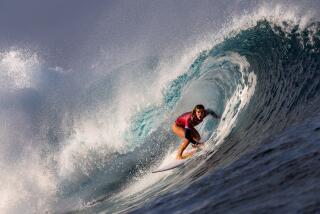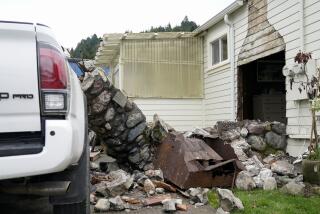Surfing on a Different Wavelength
Old-time surfers fondly recall the days when a journey in search of perfect waves -- whether to Mexico, Hawaii or even a beach near their homes -- involved a wonderful anticipation born of the unknown.
They relied on hope and considered themselves blessed when the ocean delivered, and cursed when it didn’t.
Those days are long gone. Swell forecasting has been refined over the last 20 years, to the point where surfers can obtain, via the Internet, the date and approximate time a swell is due to arrive virtually anywhere in the world.
And now the guesswork has become even further removed.
Forecasting pioneer Sean Collins says he will unveil “a revolutionary wave-tracking device” today that he calls the Surfline Buoy. Information relayed by the strategically positioned unit will enable surfers to pinpoint when sets of waves will arrive on the south side of Huntington Beach Pier.
The unveiling coincides with the Honda U.S. Open of Surfing, which is in progress through Sunday at the pier. Competitors are to become among the first to test the new information, which will give them a five-minute lead time before waves arrive. It will also give them an idea of the size of waves coming their way.
“As a pro surfer, it’s really important to understand as much about conditions as you can before you enter the water,” said Layne Beachley, a six-time world champion from Australia. “I’m usually on the beach up to 1 1/2 hours before my heat, timing the sets with a stopwatch. But what this technology enables us to do is get a really clear picture of the patterns created by the swells.”
Surfers elsewhere, however, should not get too hopeful that a similar scenario will unfold soon. The circumstances surrounding the $75,000 Surfline Buoy, which was paid for and deployed by Scripps Institute of Oceanography, are unique.
However, Collins, 53, president of Surfline.com, points out that there was a time surfers wouldn’t dream of following, say, a northwest swell from Hawaii to Northern California to Todos Santos Island off Ensenada, in a period of just a few days. That’s common these days among renowned big-wave surfers, thanks to modern surf forecasting.
Collins envisions the day when mobile buoys are widely used at major surf contests and when other coastal buoys, similar to the Surfline Buoy, are also utilized by recreational surfers, thanks to rapid advancements in technology.
“In five years when we all have cellphones in our watches and Internet access in our watches, which will be waterproof, and you know that there’s going to be a set in five-six minutes, you won’t take off on the first little wave,” he said. “You’ll wait and position yourself. It will change the whole dynamic of surfing.”
For now, however, this phenomenon is restricted to Huntington Beach, which calls itself “Surf City” and this week will draw roughly 350,000 spectators to the Bank of the West Beach Games, featuring the U.S. Open as its centerpiece.
The Surfline Buoy, anchored two miles offshore at a depth of 70 feet, is one of about two dozen similar buoys deployed off California by Scripps as part of its Coastal Data Information Program, which is studying offshore waves and their effect on such phenomena as coastal erosion and the transport of beach sediment. The buoys also provide mariners with safety information.
Most of the buoys are much farther offshore, near the continental shelf, but a small number of near-shore buoys are required by scientists to help confirm the accuracy of swell-modeling data generated by the offshore buoys.
These are the ones that may be utilized to provide the more detailed forecasting model developed by Collins and Bill O’Reilly, a Scripps researcher who also helped Collins formulate his popular LOLA global swell-forecasting tool, which is available to Surfline subscribers.
Collins, who for years has used data gleaned from government buoys, was allowed to choose the location of the Surfline Buoy, directly in the path of swells generated far to the south. Scripps benefits through the use of Collins’ headquarters and vast computer network near the base of Huntington Beach Pier.
Sensors on the buoy measure not only the rise and fall, but the pitch and roll of the buoy, enabling scientists to calculate wave heights, the period between swells and direction from which they arrive. Collins and O’Reilly developed a computer program that converts this real-time information into set forecasts that appear as a graphic chart on the website.
The waves appear as spikes in the chart and show in minutes how far away they are from the pier. The larger the spike, the larger the wave. The chart is updated every minute.
Also on the site is a 30-minute “snapshot” that enables surfers to detect patterns that may help them determine the time between sets and the larger waves within the sets.
The system is not without glitches. Because of the buoy location, only south swells, prevalent through summer and early fall, give accurate readings. So unless the buoy is repositioned in the fall, it will be of little use to surfers. Additionally, weak, poorly defined swells, especially those raked by strong westerly winds, are difficult to detect on the charts.
However, as the U.S. Open is in the midst of a busy week of competition, news of surf forecasting’s latest innovation is spreading along the waterfront, and surfers are rushing to their laptops to see whether it’s true.
“That would be insane,” proclaimed Shaun Ward, 22, a Huntington Beach local who hinted that such information might have helped him avoid elimination Monday in the round of 192. “If a medium-sized wave came in, you could just paddle over it because you would know a bomb was coming.”
There’s always next year, he added.
*
Pat Gudauskas of San Clemente, Dane Reynolds of Ventura and Bobby Morris of Santa Barbara were among the 24 heat winners Monday during the round of 192 at the U.S. Open. Also advancing to today’s round of 144 was Pat Gudauskas’ twin brother, Dane, and Nate Yeomans of San Clemente.
Times staff writer Dan Arritt, in Huntington Beach, contributed to this report.
More to Read
Sign up for Essential California
The most important California stories and recommendations in your inbox every morning.
You may occasionally receive promotional content from the Los Angeles Times.










